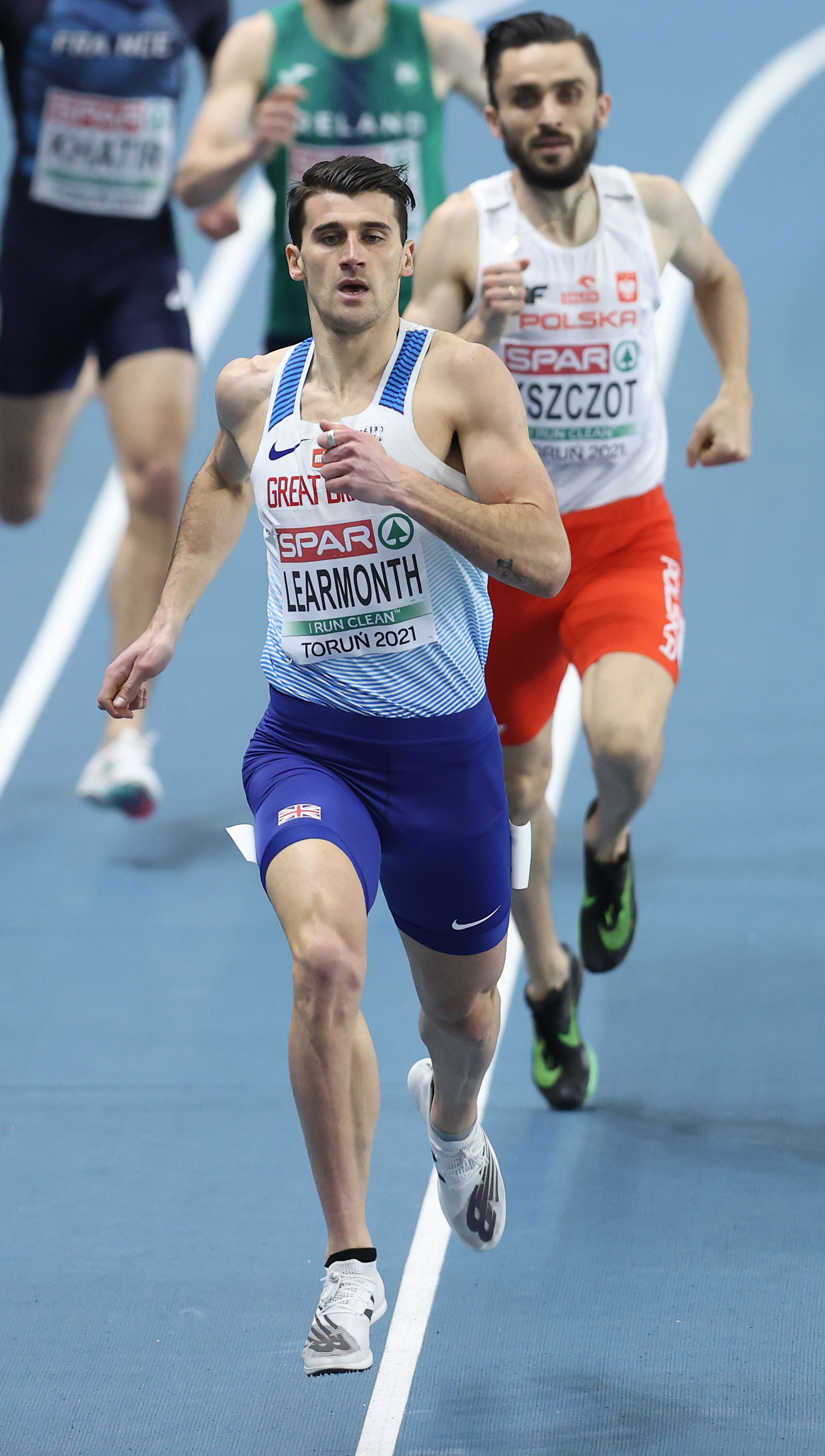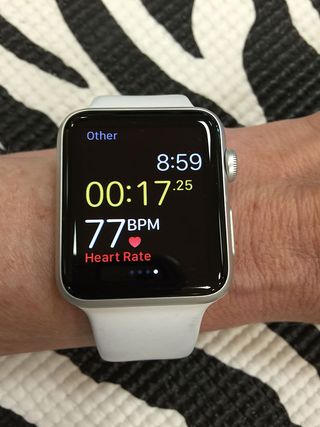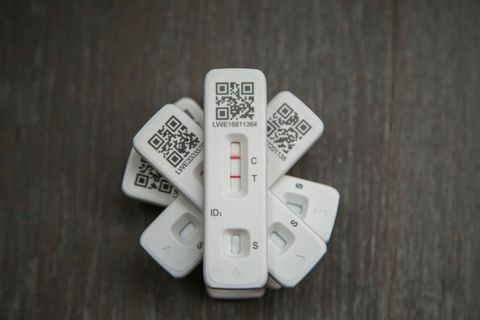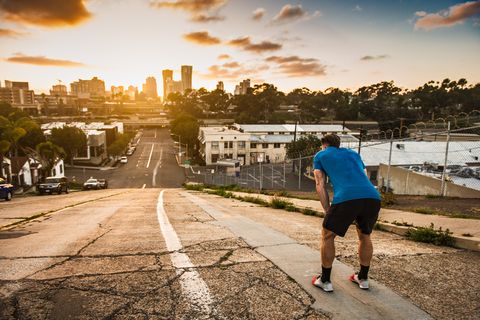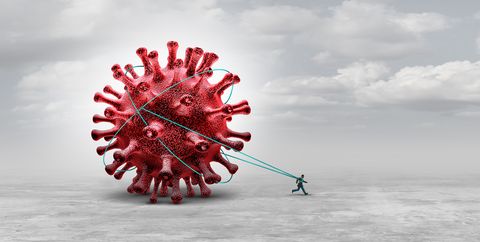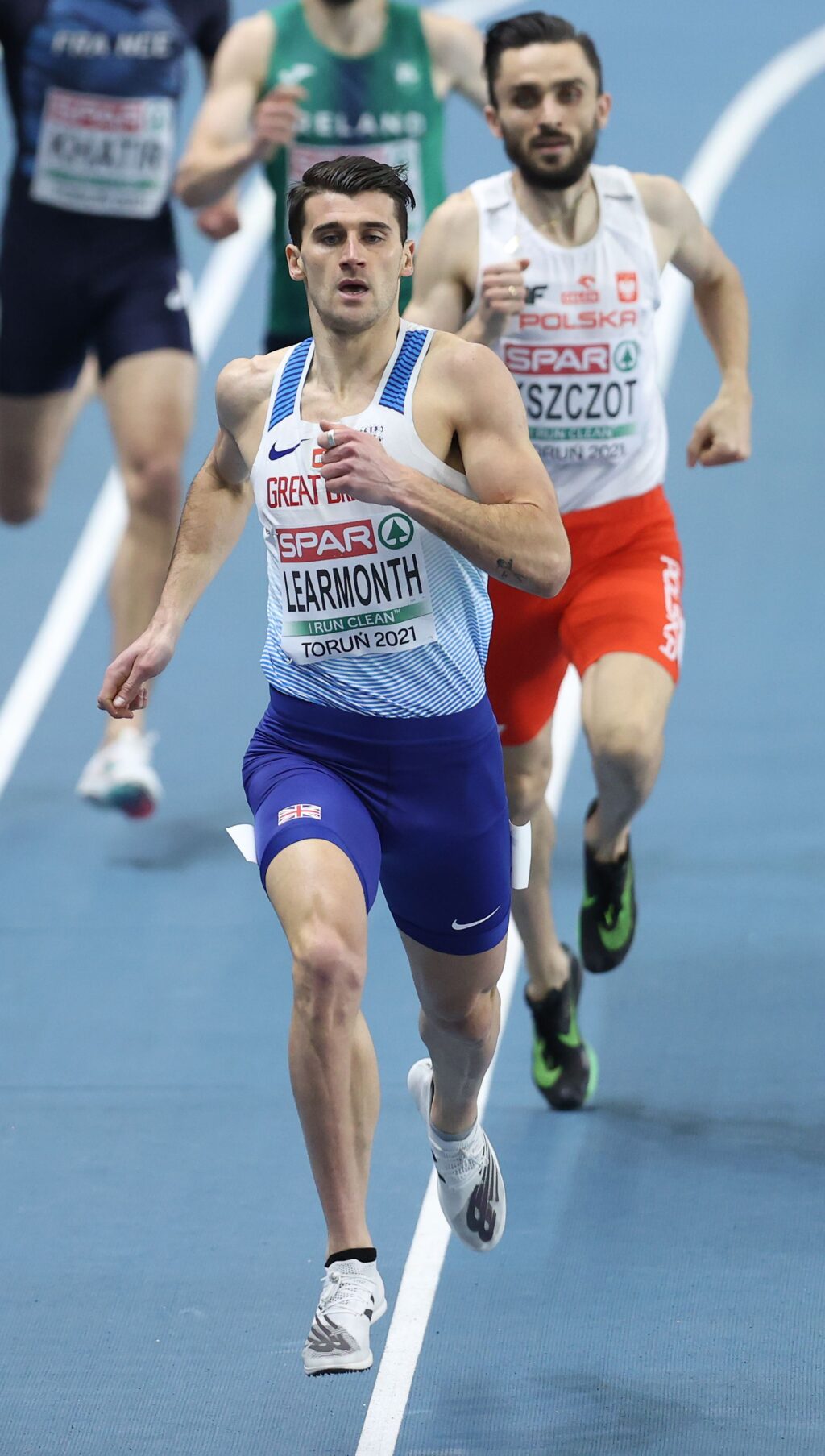
In March 2021, Guy Learmonth packed his Team GB kit and joined the Covid-secure bubble of athletes heading to Toruń in Poland, for the European Indoor Championships.
He was in great form, having recently set an indoor PB of 1:46.73 for the 800m. He hoped for a successful stepping stone on the way to qualification for the Tokyo Olympics. Things did not go to plan.
‘Unfortunately, there was a Covid outbreak,’ he explains, ‘and I was one of the athletes who came back with it. I felt awful by the semi and didn’t make the final, so I knew something was wrong. But I passed all the tests to get on the plane. The next day I felt horrendous – vomiting all night, feverish, with an awful migraine.’
A PCR test eventually confirmed what he suspected. But that was just the beginning. ‘Where I went really wrong was being really stubborn,’ he admits. ‘I had a few easy days, but got back into training straight away. I was determined I wasn’t going to let Covid affect me. I was doing an eight-mile run on the treadmill at home the day the positive result came. I thought: I’m super-fit and healthy, I’ll get through it like anything else. And that was the worst thing I could’ve done.’
Top athletes, however, excel precisely because of their sizeable stubborn streaks, so Learmonth battled on. He was soon back into seriously hard training. ‘Things just started slowly declining, and my body started breaking down. It took about three months before I could really admit that something was wrong. I tried to rule everything else out, before I finally had to accept it was Covid.’
Cautious approach
In the early months of the pandemic – with much of the world in lockdown, vaccines just a hope and daily stats of hospitalisation and death a grim routine – little was known about how the virus might affect the otherwise super-fit. In June 2020, when professional football restarted in empty stadiums, doctors working with the top clubs found alarming signs. There seemed to be early evidence that the virus was causing inflammation of the heart, which might seriously endanger elite athletes. A battery of tests for footballers, including cardiac monitoring, was clearly important – and in all positive cases, even the mildest, two weeks with no exercise was recommended.
It was a sensibly cautious approach for a new disease. In October 2020, a panel of experts published a return-to-sport pathway – the Graduated Return To Play (GRTP) protocol – in the British Medical Journal. All athletes testing positive – including professionals and Olympians, with fitness levels most of us can only dream of – should have a minimum of 10 days’ rest, and be symptom-free for seven days before starting again, which they should do very gradually. This applied to totally asymptomatic cases, too. Anyone with more serious, prolonged or complicated symptoms was advised they might need further investigations, including blood testing, cardiac monitoring and respiratory function assessment.
Caution, in other words, was vital. And if this was how careful the super-fit must be, surely the armchair athlete must be even more so? Two years on, we have considerably more knowledge about this new disease – though certainly much still to learn.
Dr James Hull, a consultant respiratory physician at Royal Brompton Hospital and the Institute of Sport, Exercise and Health, worked with Team GB athletes in their preparation for the Tokyo Olympics. He was also on a panel of experts advising the International Olympic Committee. Like many, he was concerned – particularly with the implications of Covid for the heart. ‘At the start of the first wave, there were figures being bandied about that perhaps one in four people who were athletic might get serious cardiac disease, or myocarditis [inflammation of the heart muscle],’ he says. ‘They were frightening times. But the reality now is that with larger data-set studies, we’ve found that it’s far rarer – probably between 0.7% and 3% of individuals. Most people think that real, symptomatic myocarditis is present in less than 1% of athletes.
But myocarditis was not the only concern. ‘In the early stages of Covid, we were advising people with it not to exercise for fear of the potential that their immune system could be modulated by vigorous exercise, which could possibly make them more vulnerable to deterioration,’ Dr Hull explains. ‘Hence the guidelines of leaving at least 10 days with no exercise at all.’
But much has changed since then, says Dr Hull. ‘First, we know that the incidence of myocarditis is much lower, so that risk is reduced. Second, we know that it’s a rare occurrence for an athletic individual to be hospitalised or to develop serious problems. Third, we’ve got vaccines in place, which effectively modulate the disease course and make it a far milder condition. In addition, there may be the drift of the condition to the Omicron variant, which appears to be better tolerated and more rapidly recovered from.’
Running after Covid – current guidelines
All of this has led Dr Hull to slightly less cautious recommendations for returning to exercise. It’s important to stress, as he does, that there are provisos and red flags, and that you must be careful not to ignore warning signs or take generic advice over what’s right for you. As always: listen to your body. But for those who experience relatively light or asymptomatic Covid – which thankfully is still the vast majority of us – it’s positive news. ‘We now think in terms of 48 hours where you don’t do anything at all,’ says Dr Hull. ‘Then, you can get back into some light exercise – within the parameters of isolation.’
Light, however, really does mean light: keeping your heart rate low, and never trying to make up for missed sessions. Realistically, just a couple of days off may not be nearly long enough for many. The recovery period from Covid is variable, and some symptoms are more persistent than others. So when do you know if it’s okay to run?
There’s an oft-repeated piece of folk wisdom that if the symptoms of your virus stay above your neck, then you can probably crack on. Below your neck, rest. Is it true? Dr Hull laughs. ‘There was absolutely no data or basis to support that, but I led a publication in the British Journal Of Sports Medicine last year looking at our experience of Covid in Team GB athletes preparing for Olympic and Paralympic competition. We found that those individuals who had symptoms that were localised above the neck actually did have a quicker recovery and were far more likely to get back to feeling fully back to sport, than those who had symptoms below the neck, ie the presence of breathlessness or chest pain.’
Be aware of what your individual Covid symptoms are telling you, and never ignore any red flags. ‘If you have any chest pain, palpitations, inappropriate dizziness or shortness of breath associated with chest tightness, then stop,’ says Dr Hull. ‘But if not, if you feel up to it you can restart light exercise, such as a light jog, but keep your heart rate below 60% to 70% of maximum.’
Potential complications
When looking at those Covid red flags, it’s hard not to sound alarmist, so it’s important to remember that serious complications are rare. Take myocarditis: as Dr Hull says, it’s much less prevalent than initially thought. In September 2020, a US study published in JAMA Cardiology found evidence for myocarditis in 15% of 26 college athletes who tested positive for Covid. But a larger study in May 2021 found just 2.3% – and some of those cases were ‘subclinical’ and only diagnosed after extensive testing. A third study* suggested a universal screening approach with a cardiovascular magnetic resonance (CMR) scan in Covid-positive athletes places ‘unnecessary stress on healthcare resources’, with ‘false positives and harm’ possible and ‘no known benefits’.
Another fortunately rare but potentially serious complication post-Covid is blood clotting. ‘The warning signs are sharp, stabbing pains in the chest,’ says Dr Hull. ‘If it feels like you are being stabbed with a needle, or if you get a swollen unilateral [one side] calf, such as a DVT, you should be very cautious. It might not reflect an injury or a tear or pull. Your blood is more sticky when you’ve got Covid, so you’ve got to be careful if you do have a clot not to assume it’s something else.’ If you suspect a clot, seek medical help as soon as possible.
And what about your lungs? We have seen reports of serious lung damage after a Covid infection, and complications that don’t seem to respond to standard medication. Covid can cause pneumonia and, in severe cases, acute respiratory distress syndrome (ARDS). So some runners might be nervous about giving those lungs a hard workout post-Covid. Yet one thing we do know now is that those who are physically fit and exercise regularly are giving themselves a huge advantage. ‘In general, with data we see of people coming out of Covid, there seems to be a prevalence of somewhere between 2% to 5% who have protracted changes [to their lungs] on X-rays and CT scans,’ says Dr Hull. ‘But my experience with athletes is that just doesn’t occur. I can’t think of a single athlete where I’ve seen protracted lung changes, and I’m not aware of any literature that has suggested otherwise. It was a concern at the start of the pandemic, certainly, but it hasn’t been something I’ve seen in reality.’
Dr Hull has, however, worked with many athletes – including Learmonth – who have developed breathing ‘disorders’ after Covid. ‘When we investigate that group, there’s quite a high proportion who have what looks like dysfunctional breathing, or what we might term a breathing pattern disorder,’ says Dr Hull. ‘That’s a form of condition where people tend to breathe more through the upper part of their chest or the apices of their lungs. And it becomes very inefficient because the gas exchange part of the lung is at the bottom.’
To help athletes such as these, respiratory therapists work on breathing techniques – a little like the diaphragmatic breathing that yoga regulars may have practised. Indeed, respiratory physio helped Learmonth. ‘I had a full day of testing, which found all sorts of problems with my diaphragm and my lungs, and a couple of blocked airways,’ he says. ‘I couldn’t breathe with my diaphragm, everything was in my chest. I worked with a respiratory specialist for six weeks to learn how to breathe again!’ Learmonth also says that his sleep patterns went haywire, which helped him understand why his body was simply not recovering.
While such cases are deeply frustrating for athletes, whose livelihoods depend on performances, the key thing to remember is that, for the rest of us, exercise protects. In particular, moderate activity boosts immune function. A study published in the British Journal Of Sports Medicine concluded that meeting the physical activity guidelines – and having greater fitness – decreases the likelihood of severe Covid infection. ‘Physical fitness protects from hospitalisation, development of complications, development of lung fibrosis and potentially provides a more rapid recovery from illness,’ says Dr Hull.
The lingering effects of Covid
For the many runners who love the sport as much for the mental health benefits as the physical, it’s reassuring news that with no red flags, you can cautiously return to running pretty soon after infection. Yet the reality is that Covid symptoms are often frustratingly inconsistent. You might feel good enough to attempt a run – but when you do, you feel terrible.
One reason why returning to running might feel harder than expected can be found in some fascinating research by Dr Jennifer Radin, an epidemiologist at the Scripps Research Translational Institute in California. Before Covid hit, she was working on a project using data from wearable tech to predict the spread of ‘flu in real time’. Users uploaded their Fitbit data, and by identifying the proportion each week who had abnormal data on metrics, such as resting heart rate compared with their baseline, the researchers could predict flu-like illness.
So Dr Radin and her colleagues were in the perfect position to apply this approach to the new virus. They created an app where users in the US and Australia could share data from their Fitbit, Garmin or Apple Watch and log Covid test results, or other illnesses and symptoms. This allowed tracking metrics – sleep, resting heart rate, step count – before, during and after Covid. And the results were fascinating. ‘Users who tested positive for Covid were sleeping more – even more than users who were sick but tested negative,’ explains Dr Radin. ‘We also saw larger changes in their daily step counts and resting heart rates compared with those individuals who were symptomatic but tested negative, so had some other sort of respiratory infection.’
The Covid effect was most marked in resting heart rate. Whereas healthcare professionals will accept anything between about 60 bpm to 100 bpm as ‘normal’, wearables track the individual’s own personal patterns over time and so are a great data source for actual individual recovery. And that data showed that the average Covid-positive individual did not return to their own normal resting heart rate for 79 days. In those with other illnesses, it was just four days. And 14% of Covid patients did not return to their normal resting heart rate for 79 days. In those with other illnesses, it was just four days. And 14% of Covid patients did not return to their normal resting heart rate for more than 133 days.
For many, a slightly elevated resting heart rate might not even be noticeable. But runners who use their heart rate for training may start to recognise what has become an extremely common pattern: while they may feel well enough to run, their heart rate is higher than they would expect when doing so. Everything is suddenly recalibrated: running at a pace that previously might have peaked at 80% of your max, now starts at that level. Easy efforts suddenly become steady, steady efforts become hard and hard becomes impossible. It can feel – depressingly – like you’re considerably less fit than you were.
Why might this be happening? ‘It seems likely that this goes back to some sort of inflammation, and also to the impact of the autonomic nervous system that has been found in many Covid study participants and patients, where they have trouble regulating their heart rate,’ says Dr Radin. And Dr Hull echoes her. ‘We don’t know the answer yet, but it’s probably multifactorial, and explained by some dysregulation of the autonomic control of heart rate. Potentially there are inflammatory changes and also some detraining from a recovery period – but it’s a consistent and very common finding I’m seeing in athletes, and runners and cyclists in particular.’
Another pattern highlighted by Dr Radin’s research was that Covid recovery is not linear. ‘Our study and other similar ones found that, on average, people had this initial increase in their resting heart rates that peaked, then their heart rate was actually lower than average, then it went back up again after nine or 10 days,’ says Dr Radin. ‘We don’t know exactly what’s causing this, but we think that there’s potentially some impact to people’s autonomic nervous system, so how their heart rate is regulated. There’s still much we don’t understand.’
Dr Radin’s study concluded that their results showed the ‘prolonged physiological impact of Covid infection, lasting for approximately two to three months on average, but with substantial intra-individual variability’. In layman’s terms: Covid is most definitely not just a cold, and while you might be back on your feet soon, you may find it takes you much longer to get to the point where those feet move at the same speed as before.
So two years on, the messages are somewhat mixed. Yes, if you feel okay, you can return to gentle exercise sooner than you might have thought. On the other hand, you might find it takes a lot longer to return to your pre-Covid baseline than you hoped; but perhaps you’ll be reassured by the findings that this is in itself very ‘normal’.
The recovery process from even mild Covid can be erratic and baffling, even for elite athletes. Learmonth certainly found it so. ‘What threw me was that after I recovered from the immediate symptoms, I was actually able to run really quickly over the shorter distances, but for anything in the speed endurance area, I’d just flood with lactic. Once I switched systems, my body couldn’t handle it.’ But with the help of Dr Hull and his colleagues, he’s back to full fitness and feeling positive about the future. ‘I’m just delighted I’m running well and actually setting PBs indoors,’ he says.
It’s so easy to say, and so hard to do, but when recovering from Covid, the lesson is to listen to your body because everyone is different. Exercise is vital for your health, but you can push too hard, too soon. Be gentle on yourself and play the long game. Learmonth wishes he had. ‘If I can give one piece of advice to any athlete, it would be to take your time. If it happened to me again and I had the luxury of taking two or three months off, I would. But that’s easier said than done when you’ve got three or four months to qualify for the Olympics!’
‘I’ve given up hope of any meaningful recovery’
Mysterious and potentially devastating, long Covid can be a hammer blow to some people
The Office for National Statistics estimates that 1.5 million people in the UK now have long Covid, in which symptoms including extreme tiredness, shortness of breath, chest pain or tightness, problems with memory and concentration and joint pain continue for more than 12 weeks, and cannot be explained by another cause.
The prevalence of long Covid in runners is similar to the general population and, as Andy Sawyer discovered, it can be a cruel blow. Sawyer started running in 2015, aged 50, and didn’t look back. Between October 2019 and March 2020, he ran PBs at every distance – from 5K to marathon.
Then came Covid. ‘I had typical flu-like symptoms – fever, sweats, headaches, muscle aches, slight cough – but was without doubt the sickest I’d been,’ he says. After four weeks, he felt well enough to attempt a return to work, but had occasional cognitive trouble, constant fatigue, and muscular and joint pain. In May 2020, he tried a short run/walk. ‘I still remember how difficult it felt; far worse than my first attempt at C25K,’ he says.
The next few months were a struggle, but he felt he was getting a little stronger, until one day in October 2020. ‘I couldn’t run at all – neither my legs nor my lungs wanted to know. It was like someone had flicked a switch – one day I was feeling reasonably good, the next I couldn’t manage even a few metres. I had a referral to a long Covid clinic in March 2021, but to be frank, it was a waste of time.’
His muscle pain has eased slightly, but he still has joint pain and cognitive trouble. ‘After two years, I’ve given up hope of any meaningful recovery and I’d settle for being able to run 5K again without a break,’ he says. ‘I don’t have good days and bad days, I have good minutes and bad minutes. It’s impossible to plan anything. My advice is get vaccinated and do everything you can to avoid infection. If you get infected, I’d urge taking more post-symptomatic rest. And after that, I’d build up far more gradually than I did.’
However, there is a glimmer of hope that running itself may help long- Covid sufferers. A new study from the Pennington Biomedical Research Center at Louisiana State University in the US found that exercise can be used to break the chain reaction of inflammation, which can lead to developing diabetes and depression in the months after a person recovers from a Covid infection.
